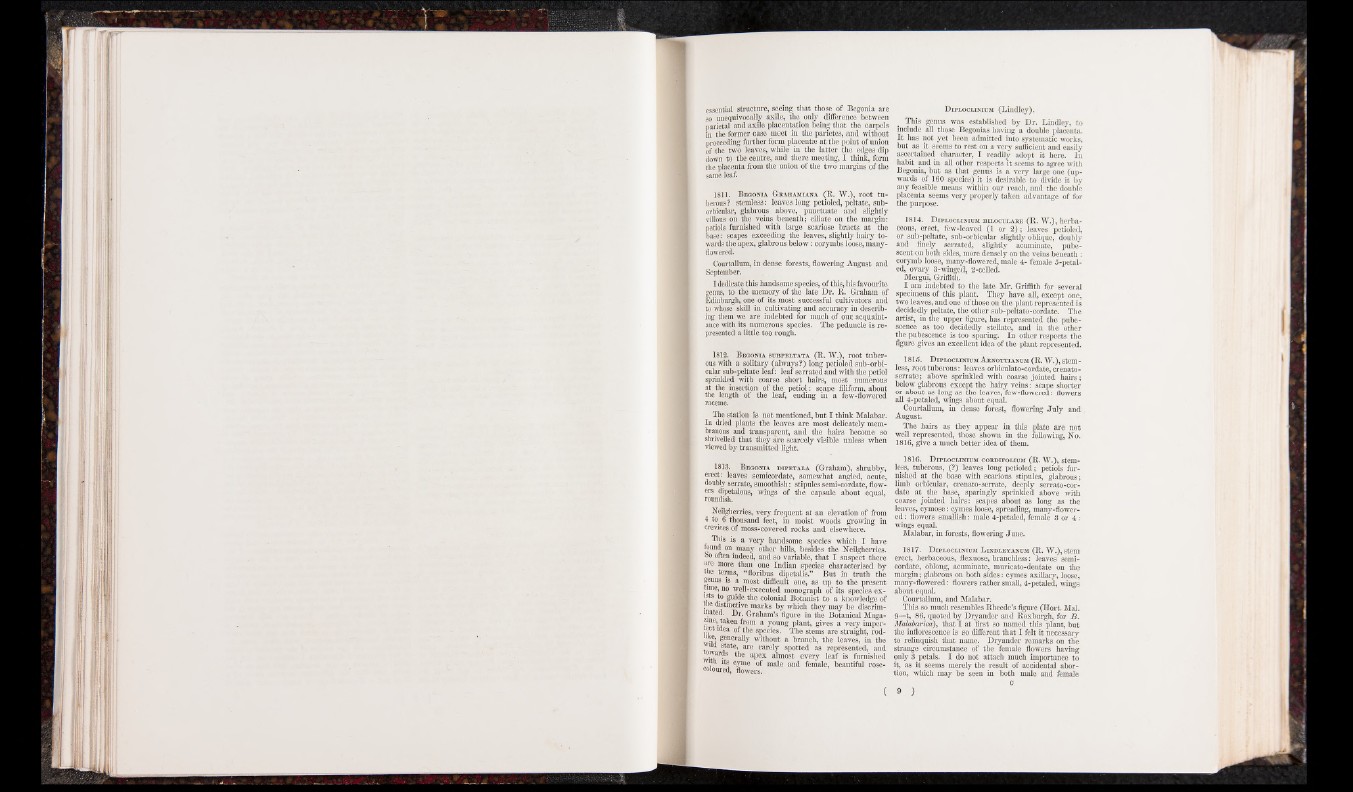
essential structure, seeing that those of Begonia are
so unequivocally axile, the only difference between
parietal and axile placentation being that the carpels
in the former case meet in the parietes, and without
proceeding further form placentas at the point of union
of the two leaves, while in the latter the edges dip
down to the centre, and there meeting, I think, form
the placenta from the union of the two margins of the
same leaf.
1811. Begonia. Grahamiana (R. W.), root tu berous?
stemless: leaves long petioled, peltate, sub-
orbicular, glabrous above, punctuate and slightly
villous on the veins beneath; ciliate on the margin:
petiols furnished with large scariose bracts at the
base: scapes exceeding the leaves, slightly hairy towards
the apex, glabrous below: corymbs loose, many-
flowered.
CourtaUum, in dense forests, flowering August and
September.
I dedicate this handsome species, of this, his favourite
genus, to the memory of the late Dr. R. Graham of
Edinburgh, one of its most successful cultivators and
to whose skill in cultivating and accuracy in describing
them we are indebted for much of our acquaintance
with its numerous species. The peduncle is represented
a little too rough.
1812. Begonia subpeltata (R. W .), root tuberous
with a solitary (always?) long petioled sub-orbicular
sub-peltate leaf: leaf serrated and with the petiol
sprinkled with coarse short hairs, most numerous
at the insertion of the petiol: scape filiform, about
the length of the leaf, ending in a few-flowered
raceme.
The station is not mentioned, but I think Malabar.
In dried plants the leaves are most delicately membranous
and transparent, and the hairs become so
shrivelled that they are scarcely visible unless when
viewed by transmitted light.
1813. Begonia dipetaea (Graham), shrubby,
erect: leaves semicordate, somewhat angled, acute,
doubly serrate, smoothish: stipules semi-cordate, flowers
dipetalous, wings of the capsule about equal,
roundish.
Neilgherries, very frequent at an elevation of from
^ to, 6 thousand feet, in moist woods growing in
crevices of moss-covered rocks and elsewhere.
This is a very handsome species which I have
found on many other hills, besides the Neilgherries.
bo often indeed, and so variable, that I suspect there
are more than one Indian species characterised by
the terms, “floribus dipetalis.” But in truth the
genus is a most difficult one, as up to the present
time, no well-executed monograph of its species ex-
Jf!f Jf, .S^de the colonial Botanist to a knowledge of
the distinctive marks by which they may be discriminated.
Dr. Graham’s figure in the Botanical Maga-
zine, taken from a young plant, gives a very imper-
ect idea of the species. The stems are straight, rod-
.,®j 8enerally without a branch, the leaves, in the
wua state, are rarely spotted as represented, and
wards the apex almost every leaf is furnished
M lt;s cyme of male and female, beautiful rose-
coloured, flowers.
D ipeoclinium (Lindley).
This genus was established by Dr. Lindley, to
include all those Begonias having a double placenta.
I t has not yet been admitted into systematic works,
but as it seems to rest on a very sufficient and easily
ascertained character, I readily adopt it here. In
habit and in all other respects it seems to agree with
Begonia, but as that genus is a very large one (upwards
of 160 species) it is desirable to divide it by
any feasible means within our reach, and the double
placenta seems very properly taken advantage of for
the purpose.
1814. D ipeoclinium bilocueare (R. W.), herbaceous,
erect, few-leaved (1 or 2 ); leaves petioled,
or sub-peltate, sub-orbicular slightly oblique, doubly
and finely serrated, slightly acuminate, pubescent
on both sides, more densely on the veins beneath:
corymb loose, many-flowered, male 4- female 5-petal-
ed, ovary 3-winged, 2-celled.
Mergui, Griffith.
I am indebted to the late Mr. Griffith for several
specimens of this plant. They have all, except one,
two leaves, and one of those on the plant represented is
decidedly peltate, the other sub-peltato-cordate. The
artist, in the upper figure, has represented the pubescence
as too decidedly stellate, and in the other
the pubescence is too sparing. In other respects the
figure gives an excellent idea of the plant represented.
1815. D ipeoclinium Arnottianum (R. W.), stemless,
root tuberous: leaves orbiculato-cordate, crenato-
serrate; above sprinkled with coarse jointed hairs;
below glabrous except the hairy veins: scape shorter
or about as long as the leaves, few-flowered: flowers
all 4-petaled, wings about equal.
CourtaUum, in dense forest, flowering July and
August.
The hairs as they appear in this plate are not
well represented, those shown in the foUowing, No.
1816, give a much better idea of them.
1816. D ipeoclinium cordipoeium (R. W.), stemless,
tuberous, (?) leaves long petioled; petiols furnished
at the base with scarious stipules, glabrous;
limb orbicular, crenato-serrate, deeply serrato-cor-
date at the base, sparingly sprinkled above with
coarse jointed hairs: scapes about as long as the
leaves, cymose: cymes loose, spreading, many-flowered:
flowers smallish: male 4-petaled, female 3 or 4:
wings equal.
Malabar, in forests, flowering June.
1817. D ipeoclinium Lindleyanum (R. W.), stem
erect, herbaceous, flexuose, branchless: leaves semicordate,
oblong, acuminate, muricato-dentate on the
margin; glabrous on both sides: cymes axiUary, loose,
many-flowered: flowers rathersmaU, 4-petaled, wings
about equal.
CourtaUum, and Malabar.
This so much resembles Rheede’s figure (Hort. Mai.
9—t, 86, quoted by Dryander and Roxburgh, for B .
Malabarica), that I at first so named this plant, but
the inflorescence is so different that I felt it necessary
to relinquish that name. Dryander remarks on the
strange circumstance of the female flowers having
only 3 petals. I do not attach much importance to
it, as it seems merely the result of accidental abortion,
which may be seen in both male and female
c